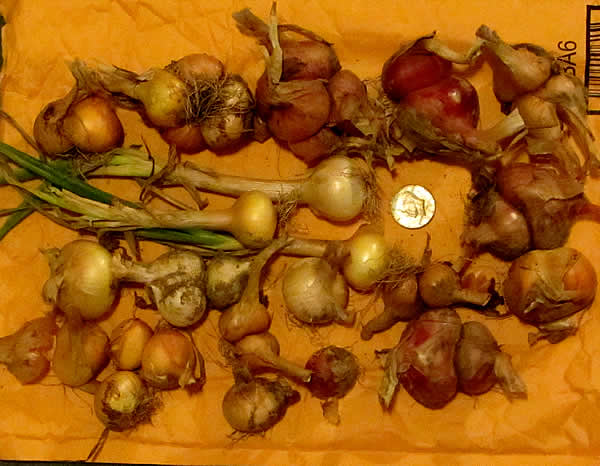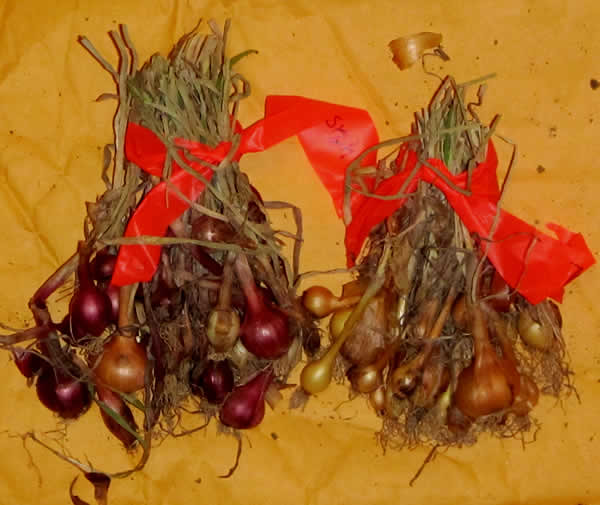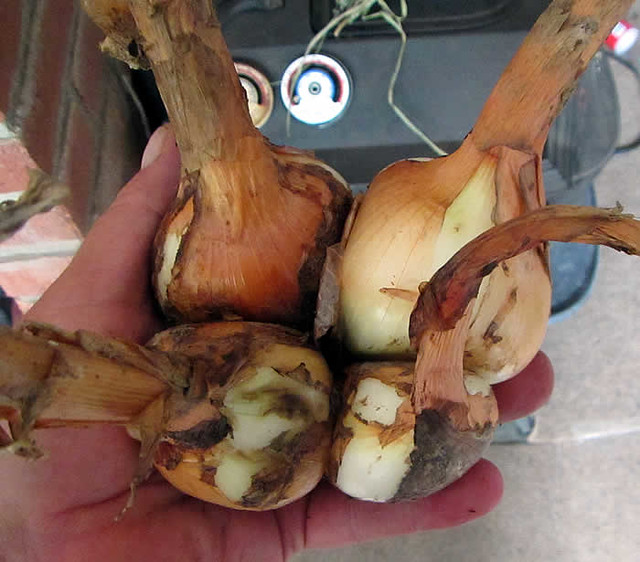|
|
Post by reed on Jul 25, 2017 7:36:22 GMT -5
Update: I will start all TPOS indoors in flats from now on and then transplant out at the appropriate time. What really is the appropriate time? That is actually a question I deal with on a lot of things. Carrots, cabbage, radishes, I'v been gardening a long time but relatively new at seed saving except for easy things like beans or tomatoes. I am also very interested in finding or adapting things that can kind of just take care of themselvese. Concerning my TPOS, I have harvested and am now drying the ones started in flats this spring and the fall direct sown. The spring ones are actually the biggest but that is because the fall planted were too crowded and somewhat neglected early in the season. I have back up seed and am waiting for seed on some other onions to mature. I'm going to take that as a sign that it is time to plant again. I hope to establish just by following what they would naturally do,a self regeneration crop. I also planted some TPOS, leeks, some of Joseph's landrace and some evergreen bunching onions a few weeks after I started my others this spring. I had them crowded in pots and when it started getting really hot and they had to be watered every day I dumped them out and took them inside to dry down some . They range in size form peas to marbles and lot of variations in color. A few even divided. The tops have dried but they are staying solid, I'm gonna stick them back in when the hot weather breaks or maybe sooner. It might not work but I think at least some will root down and grow for next year. |
|
|
|
Post by reed on Jul 26, 2017 4:09:36 GMT -5
I do love's my cold frames, although seems like I hardly even need them any more except maybe for peppers.
"stay with what is working for you" , best garden advice there is.
|
|
|
|
Post by Al on Jul 27, 2017 2:13:59 GMT -5
I've had similar range of colours from KWGM seed, but nothing like the scale of your success. Impressive numbers👍🏻& quality. I hoped to increase stock much more than I have, mainly because of losses when drying & storage, maybe my cool & humid Scottish air allows mould to set in as the leaves & skins dry…slowly. I get better yields & bulbs which keep well from commercial shallot varieties such as Jermor.
A bunching onion grown at my allotment site for decades has a similar story to Kelly Winterton's potato onions. Normally this onion never flowers, it is evergreen & bunches like a Welsh Onion. I have had very occasional flowers & found seed from these produces a mixture of non-bulbing salad onions like the parent, & also small bulbs of various colours.
|
|
|
|
Post by reed on Jul 30, 2017 21:06:07 GMT -5
I got a bunch of regular onions also with yellowing stalks and green umbels. Some have fallen over and the stalk partially broken but umbels are still mostly green. I'm just gonna leave them a little longer, surely they will start drying down pretty soon.
|
|
|
|
Post by davidp on Jul 31, 2017 6:52:45 GMT -5
Question: The flower stalks are yellowing but the seed ovaries on the umbels are still green. Can/should I harvest the stalks at this stage and bring them in to dry down or should I wait until the ovaries turn brown? I do not want to rush things but the sooner I get them out of the natural environment and into my control the better I will feel. Your choice, but I would bring them in now. I harvested my TPOS flower heads two weeks ago. Most of the stalks were yellow/brown and many of them had keeled over. Brought them into my basement (which has a dehumidifier going) and spread them onto a door screen to dry down. At this point, the ovaries have faded from a vibrant green to a wrinkly, dull grayish-green, and the ovary stalks are all dried out and limp, so I'm thinking that the drying process is moving along normally. This bed had Green Mountain PO, Coral Mountain PO, and Dakota Red PO planted in adjacent rows. A few beds over was a bed of Pikant shallots. They all had numerous flower tops. I separated the flower stalks groups from the GMPO and CMPO (total 51), the Pikants (45), and the DRPO (total 40) but that separation really makes no sense. The only difference between the two groups is the the GMPO/CMPO and Pikant flower heads are much larger than the DRPO. Since they were all planted in close proximity, and during the season I saw many pollinators swarming around them . . . any resultant seed from these 136 flower heads are going to contain many, many crosses. Hopefully there will be plenty of viable seed to play with down the road. |
|
|
|
Post by steev on Aug 2, 2017 0:09:24 GMT -5
Sad that we're starting to need to subvert the internet to communicate. Oh, well, I don't doubt that those of us disinclined to be subjected to such bullshit will find ways around it. Fuck the dominant paradigm! Really! Get your shit together and blow off the "official line", which will turn you to sheeple.
|
|
|
|
Post by reed on Aug 2, 2017 7:31:57 GMT -5
Most of mine look more like the larger ones that still have their tops in the one picture. The tops are completely dried on mine and I trimmed them off last night and inspected good. Most also have divided into two or more bulbs, even the smaller ones. I have one red one in particular that has four pretty good sized bulbs, way way bigger than I would have expected from seed.
Yep, gotta get the posting pictures issue figured out, not as much fun with out.
|
|
|
|
Post by reed on Aug 2, 2017 10:25:09 GMT -5
reed it sounds like you had better bulb development than I did. Are your better-developed ones from seed direct sown in location or were they from transplants from seed grown in your cold frame? From seed sown last fall or seed sown this spring? Here I go obsessing about size again. LOL I am not disappointed in the least, was just expecting larger bulbs here because the plants grew so well. I admit I could have watered my plants a little more often than I did (have only had two rain events in last 7 weeks totalling 1 4/10, not enough). Also I never fertilized them. I admit I am not a fan of fertilizing storage veggies because I think doing so adversely affects storage qualities, but that is not the reason I did not do it. In this case I simply never got around it. Looks like any bulbs I harvest that were grown from direct sown seed will be pea to marble size. Very disappointing but still usable (hopefully). I am going to be harvesting all of the TPOS flower umbels today. Some insect is chewing holes into the ovary shells and I can see the black seeds inside. The larger ones are from cold frame transplants this spring although it was so warm they spent little time in the cold frame, I got tired of remembering to open it up so they wouldn't cook in the day. I imagine my direct seeded from last fall would have exceeded them except they were so neglected for awhile this spring. I didn't do any fertilizing or watering, they were planted about 6 inches apart and kept weeded. The were in the shade of some pole beans which may have protected them some from the hot sun. I have lots of pea to marble sized ones in the bunch I planted in pots a week or so after transplanting the others. I had just left them largely on their own till a little while ago when I dumped them out. I'm going to replant them pretty soon. I'm looking for the appropriate spot to direct seed some more pretty soon, maybe early September or so. I'm sure the fall direct seeded ones would have done much better it I had taken better care of them. I have this idea that planting at about the time they would have naturally planted themselves is the way to go to develop a semi wild population. Your discovery of volunteers reinforces that. I hope to end up with a self sustaining, winter hardy and winter harvest-able population. We only have a few days a year when the ground is too frozen or snow covered to prevent harvest of things that can live in cold wet clay and I already know that these can. |
|
|
|
Post by reed on Aug 3, 2017 4:25:07 GMT -5
Not sure if this picture post is going to work or not. If it does then this is my harvest of larger TPOS bulbs from seed grown spring transplants. The rest look like the ones directly under the half dollar and down in the lower left. Tops of some of the white ones don't want to dry down so I didn't trim them off.  Below are the ones I started a little later for fall sets. Those on the left are from Joseph's landrace, on the right are TPOS. These were planted a little later than the spring transplants and just left crowded in their pots with weeds till it started getting hot and dry enough that watering was too much of a hassle. I will putting them back in the ground pretty soon.  |
|
|
|
Post by reed on Aug 12, 2017 6:19:27 GMT -5
Would this be considered a potato onion? It was a single bulb purchased at the store and planted last fall. All four of its stalks made seeds this year but unlike the other store bought onions planted last fall it did this. I looks different though from the seed grown potato onions with the flat sides where the bulbs meet each other.  |
|
|
|
Post by kazedwards on Aug 13, 2017 1:45:20 GMT -5
I think all onions divide like that eventually. Bulbing onions are biannual so I think they bulb up the first year and divide when they set seed in the second year. Potato onion divide and bulb up ever year which makes different. At least I think that is the difference
|
|
|
|
Post by reed on Aug 13, 2017 6:21:20 GMT -5
I had some others in the store bought section that also divided but they made clumps of small ones and only had one bloom stalk per clump. Just that one multiplied into large bulbs. A couple others just got bigger but stayed a single. Some just rotted and died after flowering. O'well don't want to get off track on the TPOS thread. I might take some pictures and start a separate thread for the store bought experiments.
|
|
|
|
Post by reed on Aug 13, 2017 14:59:06 GMT -5
Yeah this was discussed in the recent past on HG, maybe a year or so ago, it is an interesting subject. Going back and rereading it is on my to-do list because that discussion is what convinced me to mix second year regular type onions into my new TPOS seed bed here and there to get some cross pollination with my potato onions and shallots. I kinda dropped the ball this year but I did grow out Red Wethersfield for this purpose and have them coming, at least it is a start. I want other old OP onion varieties as well, especially cipollini/borettana and bottle onion types. I assume I would lose a lot of the potato onion characteristics in much of the resulting seed but there should be a few results to my liking. Am only looking for that one gem, but an OP landrace mix of onions or even just perennial onions that bloom somewhat consistently would be interesting to me as well. reed if you could get those plants in your hand to bloom and produce seed consistently that is the kind of thing I am really looking for - a regular onion with a decent dividing trait. I would really like to get some of that seed from you if at all possible. Do you know right off where we were discussing the grocery store onions? I can't seem to find it and I got some interesting info about some I remember mentioning before. I don't have as many of the seeds as I should have due to gross negligence on the part of the gardener, still I have more than enough to share some. They are mixed up though, both in maybe being crossed as all the different store bought ones grew together and no sorting or separation when saved. I'll add them to the list. |
|
|
|
Post by davidp on Aug 18, 2017 9:38:10 GMT -5
So, having harvested my TPOS crop last month, and putting them out to dry/cure outside on racks, the last couple days I've been paring away at all the dead stems and skins on the bunch. Of course, I'm seeing things now that I did not see during harvest. The most interesting item that popped up are these unique-looking ones which remind me ever so much of the Red Torpedo onions, originally called Cipolle de Tropea, named after the town (Tropea) in Italy where they originated. The Tropea onions are not seen in supermarkets, but can be found at some farmers markets. They are sweet and delicious, but have a short storage life, usually 2-3 months. So they are considered a summertime/early fall delicacy. Imagine my surprise yesterday to find these in the piles. Out of the 500+ bulbs fromn my TPOS harvest this year, only two of these plants, both doubles, have showed up. I'm really hoping these 4 bulbs can survive until next spring to be planted out. The first photo is a stock image of a bunch of Tropea onions. The second photo is of my 4 bulbs.   |
|
|
|
Post by reed on Aug 19, 2017 5:48:42 GMT -5
Except of those I'm saving to eat I'm gonna replant my onions pretty soon. Might have already done so except it has been so awful dry. We don't have a lot of storage space and I'm looking for winter hardy crops is why I replant late summer/fall. I'm really looking for largely self sustaining perennials even if they don't produce large bulbs.
Is selection for long storage why you save and plant in spring?
|
|